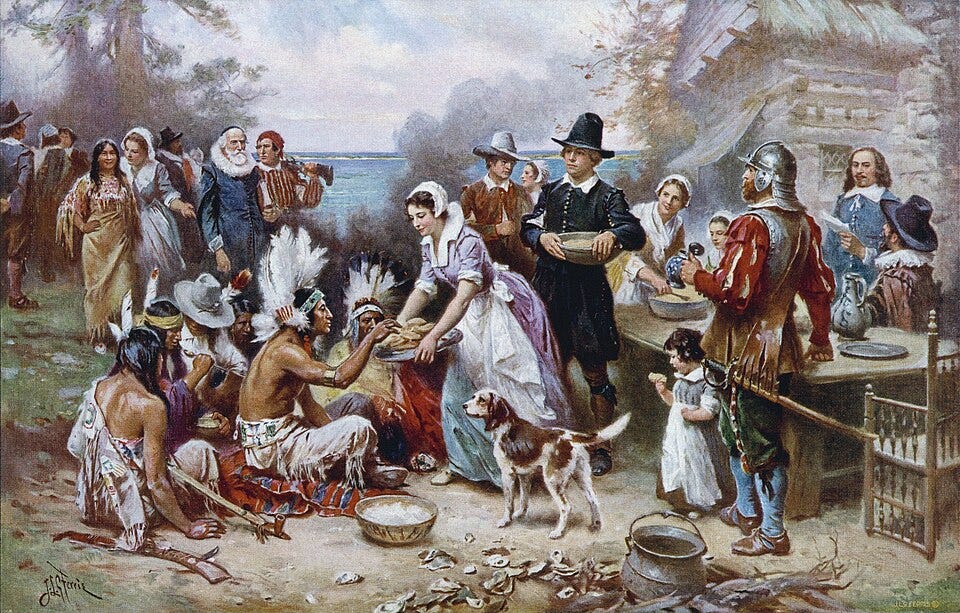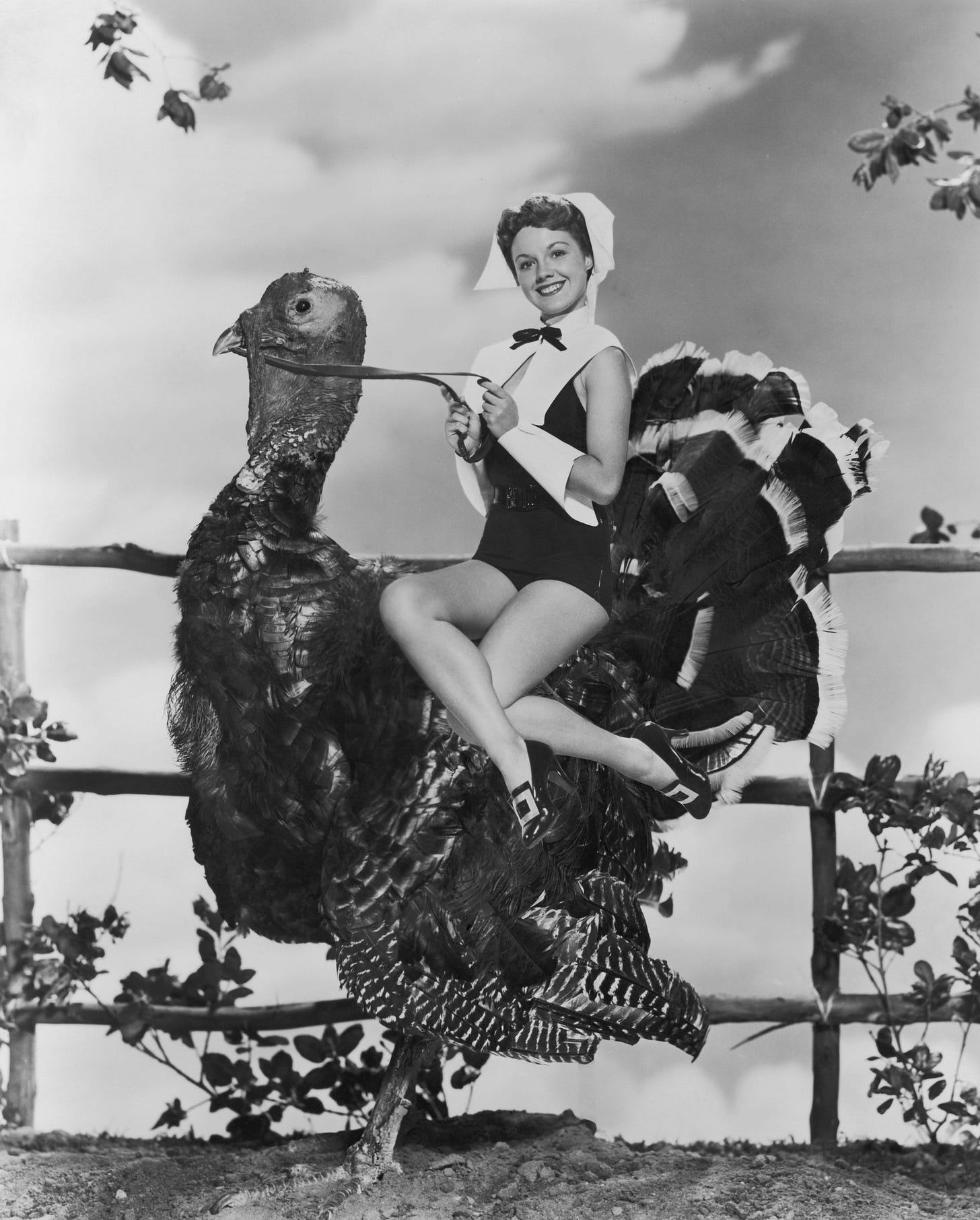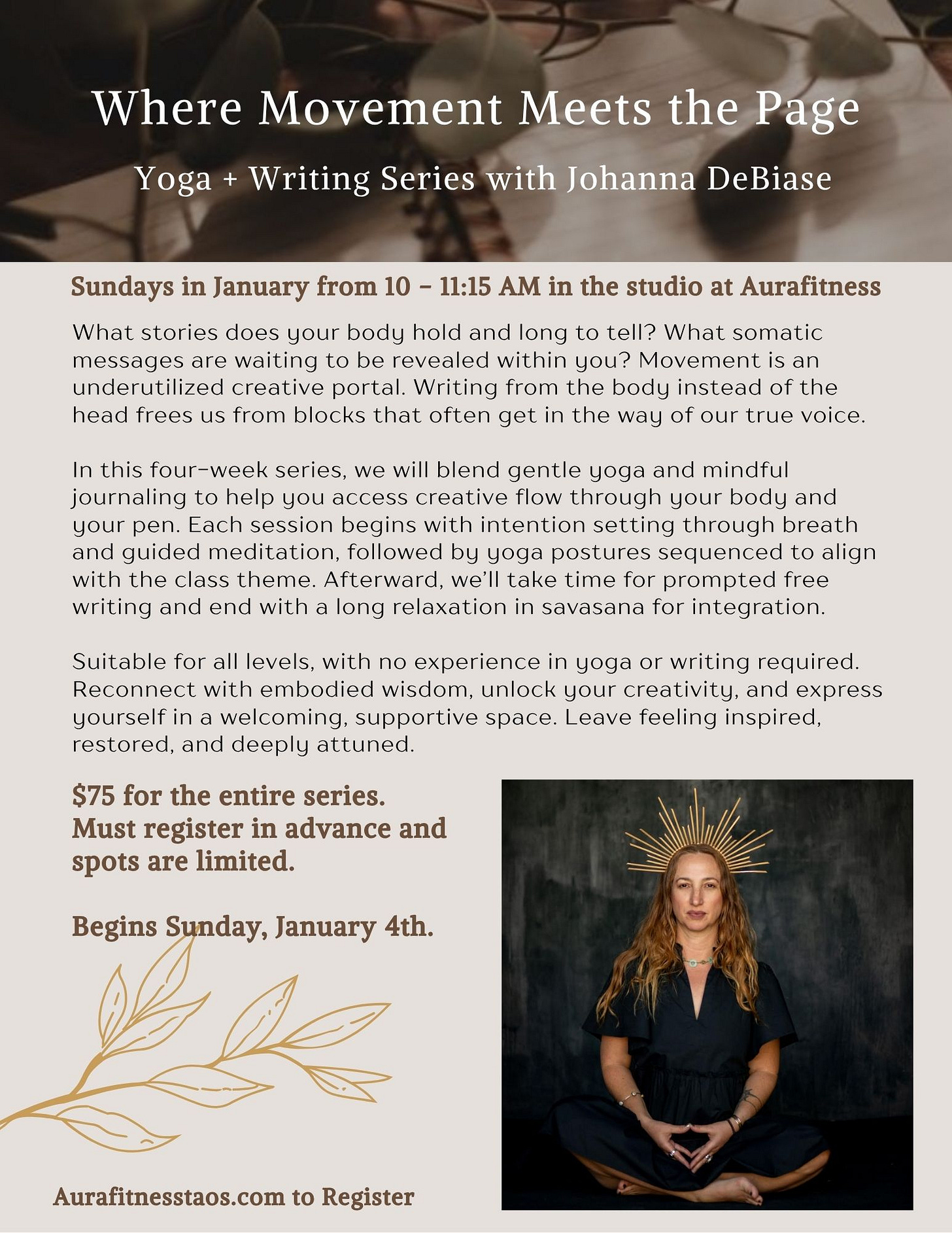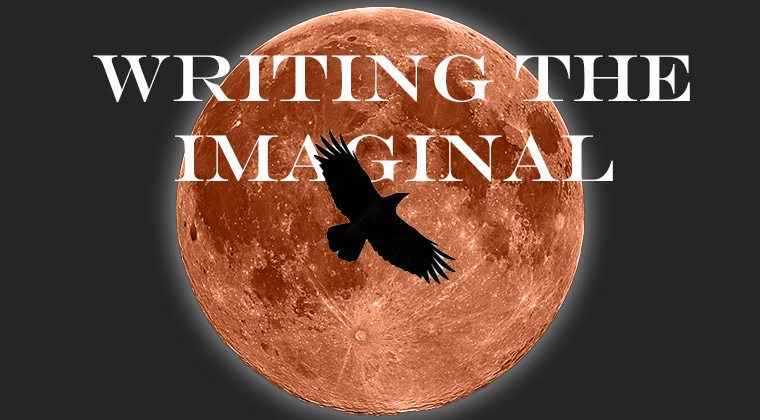Reconciling Thanksgiving
+ a Gratitude Game to Play at the Table
*If this essay feels familiar, you’re one of our longtime readers. The original version ran in 2022 on our earlier blog. It’s been revised but not by much. Thanks for sticking with us all this time.
Nostalgia for Childhood Thanksgiving
When I think of Thanksgiving, I think of Nanny, my maternal grandmother, Florence Lillian Finkelstein. I fondly recall my beautiful grandmother seated at the head of the table in her handmade fashions and clip-on earrings, laughing at the kids antics. My childhood Thanksgivings were facilitated by my mom, my aunt and Nanny and were a testament to the matriarchal strength of our family. Like every family, we gathered with all the cousins to eat the ritual foods of the festival. After having been married and accumulating in-laws, I now know that these dishes can be very different for each family.
My New York family was fairly conventional with sweet potato and marshmallow casserole, green bean and mushroom casserole with crunchy fried onions on top, canned cranberry sauce still in the shape of the can, boxed stuffing and mashed potatoes. My husband’s midwestern-based family prefers homemade “dressing,” Jello salad (such a strange invention!) and a cheese and nuts version of ants-on-a-log. And of course, both families have turkey. But truly the best part of Thanksgiving is getting together with loved ones to share a special meal and express our gratitude for the year past.
The False Myth of Thanksgiving
In elementary school, I was taught that the Thanksgiving meal we celebrate in America each year was a covenant of peace between the Indigenous peoples and the settlers. This peace didn’t last more than a generation. It is well established at this point that Thanksgiving is propaganda, a hype job fed to us at a young age, a very wholesome myth of pilgrims and Indians.
In this myth, pilgrims were described as refugees seeking religious freedom. We now know that Puritans practiced domination and colonization, deeming themselves superior to the “heathens,” as well as to the natural world. And though they were fleeing religious persecution, they hypocritically burned at the stake anyone they considered not puritanical enough.
Many indigenous people of our country would prefer we not celebrate this myth at all. And that makes total sense to me. It’d be like if Germans celebrated annually a historic peaceful dinner between Jews and Nazis prior to the Holocaust. Instead, Indigenous people consider Thanksgiving a day of mourning and a day of protest against racism and oppression.
I was also raised with the myth that this land was an unruly wilderness when the pilgrims arrived as opposed to the reality, which was a sustainably well-tended food forest. I was taught that “Indians” were superstitious and naïve. I now understand that not only did they have many technologies that were disregarded by Europeans, but that animism is no more superstitious or naïve than Christianity and for me, more rational than any other human philosophy I’ve come across. Call me a heathen.
Thanksgiving’s Turkey Slaughter
Making matters worse, I am disgusted by the massive amount of turkey that is slaughtered for this one day and the ecological damage it causes. The majority of the 46 million turkeys eaten on Thanksgiving each year are raised in horrific conditions under states of abuse before being mechanically slaughtered. A quarter of all turkeys eaten in one year in America are eaten on Thanksgiving, causing high greenhouse gas emissions, vast resource use, food waste, and water pollution.
There were a couple of years in my youth when I tried to introduce a tofu quinoa casserole to Thanksgiving dinner since I didn’t eat turkey (this is long before Tofurky was a thing), but no one ate it. Nowadays, I am happy to subsist solely on side dishes for Thanksgiving, which I think are the best part anyway.
Reconciling a Harmful Myth with a Family Holiday
So how do I reconcile these two very different sides of Thanksgiving? Thanksgiving is a family tradition, one of the few cultural events in a country deeply lacking in its own culture. Children get a whole week off from school to spend time with extended relatives. It brings people across the states together in joy and gratitude. It brings me into communion with my grandmother’s memory. Juxtaposed with the fact that for Indigenous people, Thanksgiving represents the failures of American history and the mass genocide of their people.
For me, Christmas holds a similar tension between the myth behind it and the spirit of the holiday. In my youth, I took a break from celebrating Christmas so I could work extra shifts at my job, as well as to protest the gross consumerism of the holiday. I am not Christian, and the holiday is about the birth of Jesus. Meanwhile, as a pagan, it was obvious to me that the holiday was really intended to co-opt the traditions of Yule and Winter Solstice, as we actually have no idea when Jesus was born and the evidence we do have is that he was born in springtime.
But when I started a family of my own, Christmas took on a new meaning. It is a fun tradition now that we shape in our own special way by going into the woods to get our tree, doing a puzzle together each year and watching Elf for the umpteenth time. And while I call it a Yule celebration, we still celebrate on Christmas day like everyone else, with gifts from Santa.
Historical Context is Important
I would love it if we could change the name of Thanksgiving and wipe the slate clean, rid ourselves of the terrible lies behind it. I would love for it to be nothing more than a harvest festival when the fields have been cleared and everything has been canned and stocked in the root cellar and we can take time to look at our food cache to see if we’re going to survive winter or not, a time to be grateful for what we have. Unfortunately, changing the name of Thanksgiving is just a band-aid for the harm it causes.
I don’t have a solution. I don’t know how to reconcile my desire to spend time with friends and family with my integrity that tells me to boycott the whole mess.
My compromise, which is not enough if I’m honest with myself, has been to reframe Thanksgiving as a day of gratitude that has nothing to do with American history or turkeys. I’m grateful for the more-than-human world that continues to nurture me and provide solace through good and bad. And as I sit down for my harvest dinner with people I love, I remember that all of this would be impossible without the help of the nature beings and all the people and animals that gave their life to contribute to our meal.
Gratitude Game for the Table
There is a gratitude game that I like to play sometimes with my family at dinnertime and I offer it up to you for this holiday season. It is especially great to play with kids to get them involved in thinking about the interconnectivity of all beings on the planet.
Starting with the soil, rain, sun and seeds, name and give thanks to every being that contributed to every piece of food on the table. (If it’s easier, pick one dish.) Start with the obvious, but don’t forget to name the less obvious, like the mushrooms that compost the soil, the truck drivers that ship to the grocery store, the fork manufacturers that create our utensils to eat the food with and microbes that help us digest the food.
Through this exercise, we can begin to unravel the mass production, environmental impact and the care that went into one meal. Consider how far we have come from that first autumn harvest meal back in 1621 with the Wampanoag Indians at Plymouth when everything was gathered from the land by the same people who ate the meal.
Haudenosaunee Thanksgiving Address
Another wonderful tradition to add to your Thanksgiving meal is to read aloud the Haudenosaunee Thanksgiving Address, also known as “The Words That Come Before All Else” (Ohen:ton Karihwatehkwen), a traditional Haudenosaunee (Iroquois Confederacy) oral invocation that opens and closes gatherings, ceremonies, and daily routines by offering gratitude to all elements of the natural world. This is one way to honor the Native Americans who stewarded the land we are on for centuries before us, as well as the land that continues to provide for us despite our careless extraction of natural resources and abuse of our habitat.
Greetings to the Natural World
The People
Today we have gathered and we see that the cycles of life continue. We have been given the duty to live in balance and harmony with each other and all living things. So now, we bring our minds together as one as we give greetings and thanks to each other as people.
Now our minds are one.
The Earth Mother
We are all thankful to our Mother, the Earth, for she gives us all that we need for life. She supports our feet as we walk about upon her. It gives us joy that she continues to care for us as she has from the beginning of time. To our mother, we send greetings and thanks. Now our minds are one.
Go here to read the full address.
Thank You
As always, whatever you choose to celebrate or not celebrate, we wish you the best. We are grateful for you—our friends, family and community of subscribers that are the reason we show up every week. We would love to hear how you celebrate Thanksgiving or any fun gratitude practices you and your family have.
Another Thanksgiving Memory
Thanksgiving
by Johanna DeBiase
Though we’re not in Stockbridge or even
Massachusetts for that matter, (actually
we’re north on the Taconic- I love saying
that word, and the foliage spread is compelling
my too-sarcastic-for-nature adolescent brain to
pause in awe, like, dude, the leaves are cool—
heading for my aunt’s outside of Albany for the
annual gathering of my Jewish and hence, more
humorous, familial half) and even though it’s not
1969 but more like 1989, and my mother is forcing
me to listen to public radio and the words that
spew from car stereo in a repetitive drone that appear
to have no meaning to my life (because there is
nothing about Dave Stein or Matt Fine or the new
Nirvana album or the sale at the mall or how I’m
going to pass my cruel cruel geometry midterms
next week but instead, Nicaragua or the USSR or
some such political programming,) inevitably like
Santa ornaments on Black Friday, the most predictable
of holiday traditions and warm fuzzies, (I would never
in a million Junior Proms admit it to my friends) the
most nostalgic eighteen minutes in the life of anyone
born between WW2 and the Cold War, Arlo Guthrie’s
illegal dumping of a busload of trash and draft dodging
adventures: You can get anything you want at Alice’s
Restaurant. It is in that unelected one-fifth of an hour,
when my mother starts singing, and I join her for a
two-part harmony, that life feels embarrassingly real,
like a vintage Hallmark card scavenged out of a free-bin
at the local flea market, when I forget the historical farce
that Thanksgiving truly is, and maybe even my smug
self-conscious pubescent self, long enough to enjoy the day.
The Invention of Thanksgiving
Announcement: Upcoming Event in Taos
Writing Class Available Online Now
This asynchronous two-hour online course in 6 parts draws on divination, dreams, and EFT to explore deeper realms of creativity and relief from writer’s block. We discuss ways in which rituals can be used to enhance our writing practice and how to create your own.
The final 45-minute yoga nidra practice will guide you into a relaxed theta state, using creative visualization to generate inspired writing. This workshop is for writers of all genres. $15, no experience necessary.






